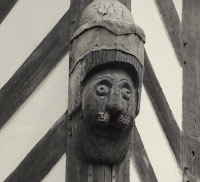Warwick is the county town of Warwickshire, located beside the River Avon. It has been settled since Anglo-Saxon times. Unfortunately, in 1694 a devastating fire swept through the town and destroyed many (but not all) of the buildings. After the fire, many changes were made, in terms of both the town layout and the regulations surrounding the construction of new buildings.
One of the buildings which partially survived the fire was the lovely Collegiate Church of St. Mary. The church was originally built nearly 900 years ago, and contains the tombs of many people of note. Robert Dudley, favorite of Queen Elizabeth I, and his wife Lettice have a tombs in the church, as well as Richard Beauchamp (who presided over the trial of St. Joan of Arc), who gave his name to the chapel. Another tomb contains the remains of Thomas Beauchamp and his wife Catherine. This tomb is notable for the fact that the effigies of the couple are depicted as holding hands.
The town is also bordered on each end by East Gate and West Gate. It was through these gates that people would enter and exit the city of Warwick. The openings in the center of the towers show where travelers had to pass. At the top of each tower was also a chapel, where people preparing to leave the safe confines of the city would stop to pray before embarking on their journeys. There is also a fragment of the old city wall left, although no one is certain whether the wall encircled the entire town, or just portions of it.
Not so pleasant aspects of Warwick's history are also pointed out, including the building where the public scaffold used to be, the location of the public stocks, and a dungeon that used to hold "Quakers and non-conformists." A fascinating old cell door from the prison is also on display, showing just how securely prisoners were kept away from the rest of society!
Robert Dudley's influence is still felt in Warwick in the Lord Leycester Hospital. This lovely old building originally dates from the 1400s when it was built as a guild hall. In 1571 Dudley took over the building and designated it as a "hospital" (in terms of hospitality, not medical, we're assured!) for old soldiers who retired from the service of Queen Elizabeth I. The building is beautiful but also somewhat scary, as it does look as if it's getting ready to collapse into the street. We are assured that it has always looked that way, however, due to being constructed with unseasoned oak (as most things were in those days, because it was easy to work with).
 The town is dominated by the lovely Warwick Castle, which was originally started in the 11th century, and rebuilt in stone in the 12th century. Throughout its history it passed through several hands, and even was used as a prison during the English Civil War. King James I gave the castle to Sir Fulke Greville, who repaired it after many years of neglect and turned it into a country home in the early 1600s. It is now operated as a tourist attraction.
The town is dominated by the lovely Warwick Castle, which was originally started in the 11th century, and rebuilt in stone in the 12th century. Throughout its history it passed through several hands, and even was used as a prison during the English Civil War. King James I gave the castle to Sir Fulke Greville, who repaired it after many years of neglect and turned it into a country home in the early 1600s. It is now operated as a tourist attraction.The DVD is arranged so that the viewer has several ways of watching. First, you can just play the
 DVD and join Dr. Pinches as she takes a walk through the city, pointing out highlights along the way. There is also a map, with numbered points of interest. If you choose this option, you can jump to any number on the map and go to that point in the walk. The chapters are also displayed, so you can easily jump back to a favorite location and watch it again! The DVD also includes extra interviews with some of the local experts from the film, as well as helpful Visitor Information.
DVD and join Dr. Pinches as she takes a walk through the city, pointing out highlights along the way. There is also a map, with numbered points of interest. If you choose this option, you can jump to any number on the map and go to that point in the walk. The chapters are also displayed, so you can easily jump back to a favorite location and watch it again! The DVD also includes extra interviews with some of the local experts from the film, as well as helpful Visitor Information. We also learn many other interesting facts from Dr. Pinches, including how the word "eavesdropping" came into being, and why graffiti can be so useful to historians (the carved in kind, not the modern spray-painted type!).
I'm ready to visit Warwick and see all the amazing sights! I'm glad to have some guidance on what there is to see in this charming town. It was really fascinating to have Dr. Pinches point out the many intricate and fascinating details on the buildings which might otherwise be overlooked by a casual visitor. I especially liked the carving of "Old Tom" on the side of a timbered house that was originally built in 1634.
You can see a preview from the DVD at the Leofric Films website.
Disclaimer: I received a copy of A Walk Around Warwick from Leofric Films in exchange for this review


















0 comments:
Post a Comment